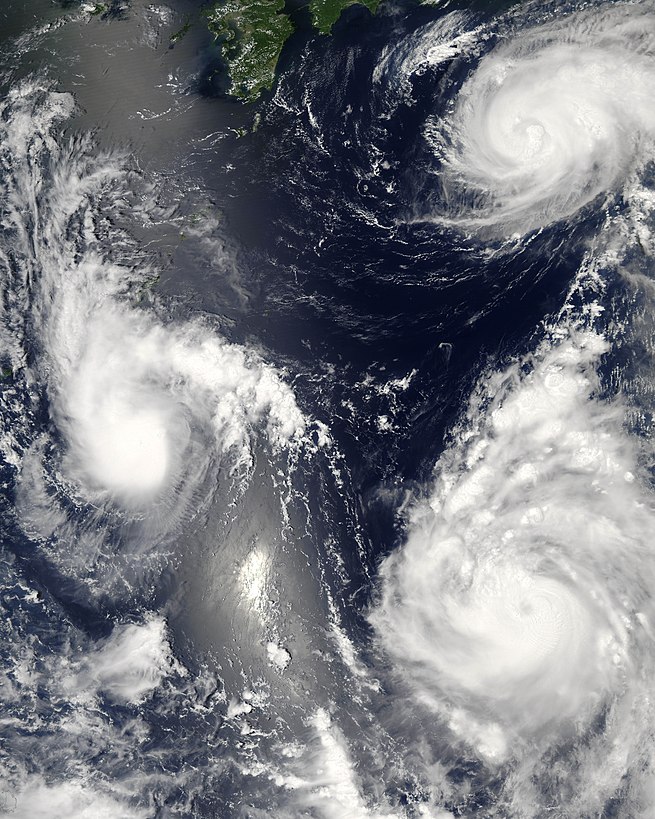Main Difference
The main difference between Typhoon and Tsunami is that the Typhoon is a type of tropical cyclone and Tsunami is a series of water waves caused by the displacement of a large volume of a body of water.
-
Typhoon
A typhoon is a mature tropical cyclone that develops between 180° and 100°E in the Northern Hemisphere. This region is referred to as the Northwestern Pacific Basin, and is the most active tropical cyclone basin on Earth, accounting for almost one-third of the world’s annual tropical cyclones. For organizational purposes, the northern Pacific Ocean is divided into three regions: the eastern (North America to 140°W), central (140° to 180°W), and western (180° to 100°E). The Regional Specialized Meteorological Center (RSMC) for tropical cyclone forecasts is in Japan, with other tropical cyclone warning centers for the northwest Pacific in Hawaii (the Joint Typhoon Warning Center), the Philippines and Hong Kong. While the RSMC names each system, the main name list itself is coordinated among 18 countries that have territories threatened by typhoons each year. Only the Philippines use their own naming list for thesystems approaching the country.A typhoon differs from a cyclone or hurricane only on the basis of location. A hurricane is a storm that occurs in the Atlantic Ocean or northeastern Pacific Ocean, a typhoon occurs in the northwestern Pacific Ocean, and a tropical cyclone occurs in the south Pacific or Indian Ocean.Within the northwestern Pacific there are no official typhoon seasons as tropical cyclones form throughout the year. Like any tropical cyclone, there are six main requirements for typhoon formation and development: sufficiently warm sea surface temperatures, atmospheric instability, high humidity in the lower to middle levels of the troposphere, enough Coriolis force to develop a low pressure center, a pre-existing low level focus or disturbance, and low vertical wind shear. While the majority of storms form between June and November, a few storms do occur between December and May (although tropical cyclone formation is at a minimum during that time). On average, the northwestern Pacific features the most numerous and intense tropical cyclones globally. Like other basins, they are steered by the subtropical ridge towards the west or northwest, with some systems recurving near and east of Japan. The Philippines receive the brunt of the landfalls, with China and Japan being impacted slightly less. Some of the deadliest typhoons in history have struck China. Southern China has the longest record of typhoon impacts for the region, with a thousand-year sample via documents within their archives. Taiwan has received the wettest known typhoon on record for the northwest Pacific tropical cyclone basins.
-
Tsunami
A tsunami (from Japanese: 津波, lit. ‘harbour wave’;
English pronunciation: soo-NAH-mee or ) or tidal wave,, also known as a seismic sea wave, is a series of waves in a water body caused by the displacement of a large volume of water, generally in an ocean or a large lake. Earthquakes, volcanic eruptions and other underwater explosions (including detonations, landslides, glacier calvings, meteorite impacts and other disturbances) above or below water all have the potential to generate a tsunami. Unlike normal ocean waves, which are generated by wind, or tides, which are generated by the gravitational pull of the Moon and the Sun, a tsunami is generated by the displacement of water.
Tsunami waves do not resemble normal undersea currents or sea waves because their wavelength is far longer. Rather than appearing as a breaking wave, a tsunami may instead initially resemble a rapidly rising tide. For this reason, it is often referred to as a “tidal wave”, although this usage is not favoured by the scientific community because it might give the false impression of a causal relationship between tides and tsunamis. Tsunamis generally consist of a series of waves, with periods ranging from minutes to hours, arriving in a so-called “internal wave train”. Wave heights of tens of metres can be generated by large events. Although the impact of tsunamis is limited to coastal areas, their destructive power can be enormous, and they can affect entire ocean basins. The 2004 Indian Ocean tsunami was among the deadliest natural disasters in human history, with at least 230,000 people killed or missing in 14 countries bordering the Indian Ocean.
The Ancient Greek historian Thucydides suggested in his 5th century BC History of the Peloponnesian War that tsunamis were related to submarine earthquakes, but the understanding of tsunamis remained slim until the 20th century and much remains unknown. Major areas of current research include determining why some large earthquakes do not generate tsunamis while other smaller ones do; accurately forecasting the passage of tsunamis across the oceans; and forecasting how tsunami waves interact with shorelines.
-
Typhoon (noun)
A knots (118km/h) or above. Equivalent to a cyclone in the Indian Ocean and Indonesia/Australia.
-
Typhoon (verb)
To swirl like a hurricane.
-
Tsunami (noun)
A very large and destructive wave, generally caused by a tremendous disturbance in the ocean, such as an undersea earthquake or volcanic eruption. Tsunami are usually a series of waves, or wave train.
-
Tsunami (noun)
A large and generally unstoppable surge.
-
Tsunami (noun)
a long, high sea wave caused by an earthquake or other disturbance
“the loss of human lives from this latest tsunami is staggering”
-
Tsunami (noun)
an arrival or occurrence of something in overwhelming quantities or amounts
“a tsunami of data pours into the CNBC newsroom every minute of every trading day”

